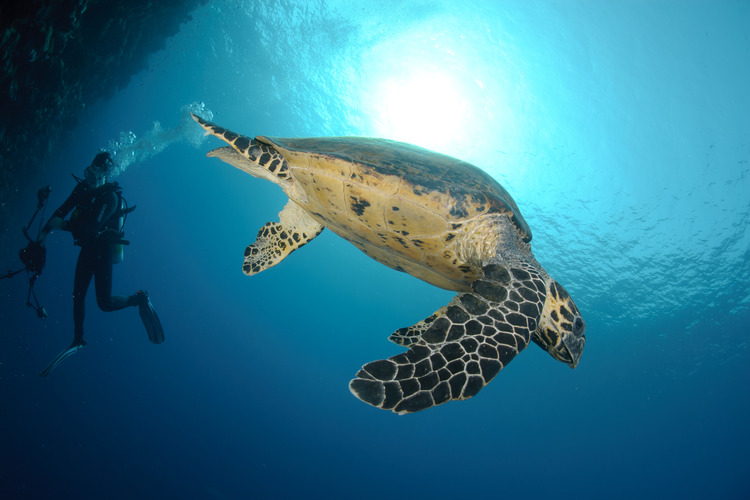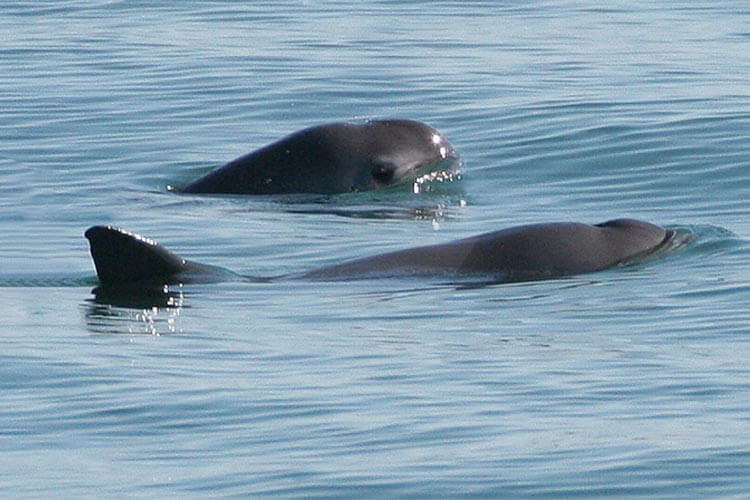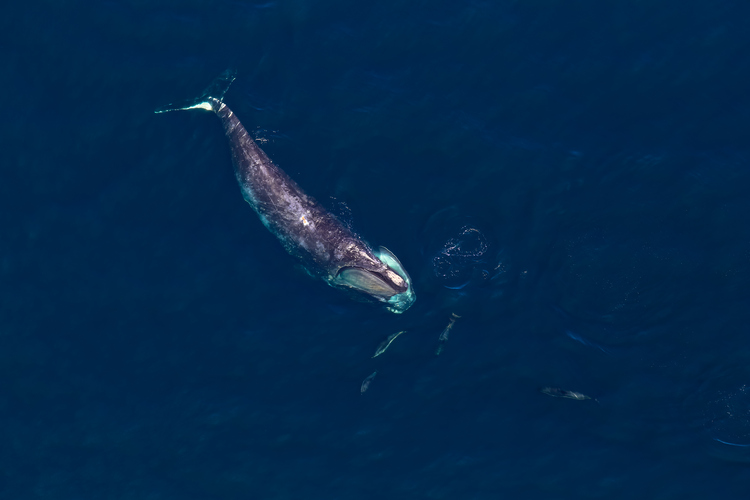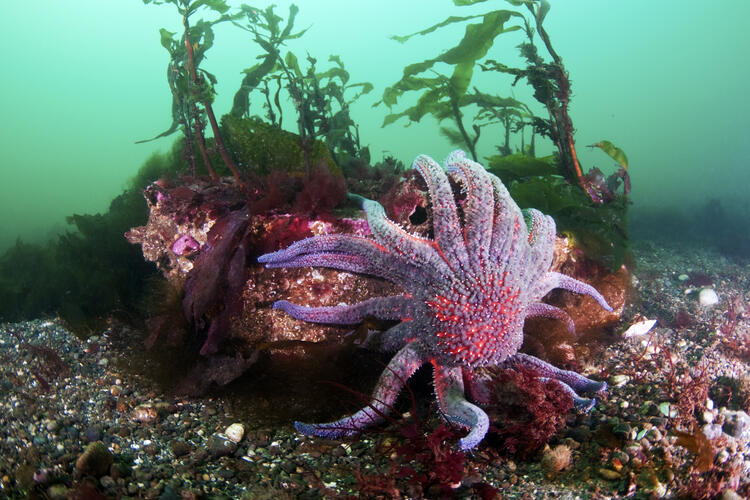
From the smallest known population of cetaceans to the sea star facing a wasting disease, here are ten of the most iconic marine species currently listed as critically endangered
According to the IUCN Red List of Threatened Species, more than 42,100 of all known species are threatened with extinction. Of those, more than 9,000 species are listed as ‘Critically Endangered’ – on the verge of extinction.
In the marine environment, 37 per cent of all sharks and rays; 36 per cent of reef-building corals; and thousands of species of fish are classified on the IUCN rankings as ‘Vulnerable’ (at high risk of extinction), ‘Endangered’ (very high risk) and ‘Critically Endangered’ (extremely high risk).
Iconic diver favourites such as manta rays, whale sharks, threshers, reef sharks and hundreds of others are currently listed as ‘Endangered’, but with their populations in decline, it’s only a matter of time before they join the most at-risk groups unless dramatic conservation measures are taken to protect them.
Here are ten of the marine species listed as ‘Critically Endangered’ as of 2023, according to the ICUN Red List, including a number of scuba divers’ favourites, such as the hawksbill turtle, ragged-tooth shark and oceanic whitetip – so commonly spotted that many divers may not even realise that they are on the verge of extinction.
Vaquita

A shy and relatively small porpoise measuring around 150cm (5ft) long, the vaquita (Phocoena sinus) gets its name from the Spanish phrase ‘little cow’ due to the distinctive black patches around their eyes and lips.
Vaquita are the world’s most endangered marine mammal species – only 18 mature adults remain in their native location in the upper quarter of the Gulf of California, Mexico. With declining numbers attributed to entanglement in fishing nets, conservation efforts focused on protecting the species have proven difficult.
Legal fishing for shrimp caused the vaquita population to decline by 67 per cent between 1997 and 2008, from 600 to 200 members. Illegal fishing for totoaba (Totoaba macdonaldi) – prized for its swim bladder for ancient Chinese medicine – has furthered the vaquita’s demise, with fishermen largely ignoring the Zero Tolerance Area (ZTA) fishing ban created to protect the small remaining population.
The cetacean’s small population size and tendency to avoid vessels mean that vaquitas are difficult to observe – although efforts have been made to monitor the cetaceans through an acoustic monitoring programme created in 2011.
Oceanic whitetip shark

With its inquisitive nature and preference for surface waters, the oceanic whitetip shark (Carcharhinus longimanus) is regularly caught as bycatch. It is also targeted by the illegal shark-finning industry as its large fins (longimanus means ‘long hands’) are highly prized on the Asian markets for use in shark fin soup.
Living in tropical seas worldwide, the oceanic whitetip shark has been known to reach a maximum length of four metres, but rarely reaches more than three. They are apex predators, feeding on a variety of prey, from tuna to other sharks.
Once the most populous shark in the ocean, the oceanic whitetip population has shrunk by more than 98 per cent in the last 61 years, leading to it becoming the only shark species to be protected by the four major Regional Fishery Management Organisations (RFMOs) focused on tuna fisheries. It was also added to Appendix II of the Convention on International Trade in Endangered Species (CITES) in 2013.
Studies are being conducted by a variety of organisations, including Cape Eleuthera Institute and Florida International University’s Institute of Water and Environment – among others – in order to locate the nursery zones where the sharks give birth to their pups. This way, young oceanic whitetip sharks can be protected to conserve the future of the population.
North Atlantic right whale

The North Atlantic right whale (Eubalaena glacialis) population have long-faced human threat. Thought by some to have been named for being the ‘right’ whale to hunt as they are slow-moving and floated to the surface when killed by whalers, the species was almost driven to extinction by the early 1890s.
Today, they are struck by vessels, caught in fishing equipment and disturbed by loud noises from human ocean activity.
First documented as a target for Basque whalers in the 11th century, right whales were hunted, as were other species, for their blubber, a source of oil used in lamps, soaps and – later – as machine oil.
Despite the stop to whaling in the 1980s, they are still being struck by shipping, caught in fishing equipment and disturbed by loud noises from human ocean activity.
The IUCN estimates that the North Atlantic right whale population did see an increase of around 2.8 per cent each year between 1990-2011 following the International Whaling Commission’s 1986 moratorium on whaling. However, the population is reported to have declined substantially since then, to between just 200-250 mature individuals.
Conservation efforts have included regulations for vessels and aircraft to keep a distance of at least 500 yards from the whales; designating zones off the coast of New England and the southeast of the USA as critical feeding, nursery and calving habitats; to the deployment of a Whale Alert App by the International Fund for Animal Welfare (IFAW) to alert those onboard vessels to the nearby presence of right whales.
Scalloped hammerhead

The scalloped hammerhead (Sphyrna lewini) is named after the ridged or ‘scalloped’ front of its head, and is found in warm and tropical coastal waters in the Atlantic, Indian and Pacific Oceans and the Red Sea.
Scalloped hammerheads spend most of their time leading solitary lives and occasionally gather in large schools – for reasons still little understood by science. These large aggregations in places such as the Galápago Islands and Cocos Island in the Eastern Pacific make them vulnerable to commercial fishers. Chinese fleets target them for their highly-valuable fins, meat and liver oil.
Scalloped hammerheads are also caught as bycatch, with studies showing that only around 20 per cent of hammerheads caught as bycatch are alive but seriously injured when they are returned to the ocean.
The population has been decimated by overfishing, leading the species to be listed as critically endangered – much like its cousin, the great hammerhead (Sphyrna mokarran) – but conservation measures have been implemented to help replenish its numbers.
A protected zone has been created – consisting of a no-take zone 30,000 sq km to the north-west of the Galápagos Islands, and a no-longline fishing zone around the existing Galápagos Marine Reserve – to form the Galápagos Super Highway, aiming to conserve a migratory corridor in the Pacific Ocean.
The Rainforest Trust has also created a sanctuary for scalloped hammerheads in Golfo Dulce, Costa Rica – a protective area that will conserve the nursery which supports the survival and development of the juvenile members of the species.
Common guitarfish

Living in shallow, sandy areas in the Atlantic Ocean and the Mediterranean Sea – with a preference for coastal waters – the common guitarfish (Rhinobatos rhinobatos) population has been decimated by more than 80 per cent in the last 42 years.
The common guitarfish’s fins and meat are regarded as a prized food in several countries, leading it to become locally extinct in the western Mediterranean Sea and around the Balearic Islands due to continual overfishing. The closely related giant guitarfishes are now the most critically endangered of all marine families.
Conservation efforts to protect the common guitarfish are underway, but often difficult to enforce. The Regional Marine Protected Areas Network in West Africa (RAMPAO) attempted to conserve several habitats for guitarfish and other species in 2007 – but failed to do so, due to lack of financial support and adequate infrastructure.
Other initiatives include organisations such as the UK’s Shark Trust conducting visits to fish markets and landing sites across Algeria, Tunisia, Libya, Israel and Cyprus, in order to speak with fishers and enforcement officers to heighten awareness of the critically endangered status of common guitarfish and its cousin, the blackchin guitarfish (Glaucostegus cemiculus).
Hawksbill sea turtle

Familiar to many divers, over the past century, the hawksbill sea turtle (Eretmochelys imbricata) population – crucial in their role alongside other species to maintain coral reefs by eating sponges which might otherwise out-compete reef-growing corals – has dropped by more than 90 per cent.
Threats such as being caught as bycatch; vessel impacts and the direct harvest of their eggs and meat in the illegal wildlife trade have had a dramatic impact on the survival of the species.
Japan imported around two million turtles for use as Japanese bekko (‘tortoiseshell’ from the hawksbill) combs, brushes and other ornaments from 1950 until a ban on the trade was enforced in 1992, although bekko souvenirs- from jewellery to entire taxidermied turtles – are still sold in Tokyo gift shops.
Continual conservation efforts have been made to protect the species – apart from the trade in hawksbill shells they are also targeted for their meat and eggs, which has had a dramatic effect on other turtle populations, especially the Kemp’s ridley turtles (Lepidochelys kempii), the second of the seven sea turtle species listed as Critically Endangered.
Global efforts to protect the turtles include a Nature Conservancy tagging programme which monitors turtles in the waters off Arnavons Islands in the Solomon Islands, where one of the largest nesting populations of the species resides; and in El Salvador, the ProCosta Project has converted local egg-collectors to egg protectors – vital support to the species which nests 80 per cent of its hatchlings in the eastern Pacific.
Sunflower sea star

Sunflower sea stars (Pycnopodia helianthoides) can be found from Baja California to the Aluetian Islands of Alaska, but their vast range is threatened by sea star wasting syndrome – an outbreak of which occurred between 2013-2017 – a disease which causes white lesions across the surface of the animal and which can lead to the arms body of the seastar deflating and disintegrating.
Over 5 billion sunflower sea stars – important in maintaining kelp forests which provide habitats, by eating kelp-feeding sea urchins – are thought to died from the syndrome, one of the worst affected populations of sea stars.
Scientists theorise that unusually warm waters between 2014 and 2016 during a marine heatwave may have helped to the spread of sea star wasting syndrome. The changes in the environment may have triggered stress response in the invertebrates, but the exact cause of the syndrome has yet to be confirmed.
Conservation of the sunflower sea star is underway, with efforts to secure crucial funding to further research into the syndrome. The Nature Conservancy created an extensive plan for the sunflower sea star’s recovery along the West Coast of the US – where the population is almost extinct – including goals to research how bycatch of sunflower sea stars affects their population.
Sand tiger shark

Sand tiger sharks (Carcharias taurus), also known as grey nurse sharks or ragged-tooth sharks (‘raggies’) in Australia, face capture as targeted fish and bycatch – often killed for their meat, hide and fins. With a preference for coastal waters, the population is also under threat from pollution and habitat clearing as coastal development occurs.
Despite their toothy and initially intimidating appearance, these sharks are relatively docile – a characteristic which makes them the most commonly kept large shark in aquariums, coupled with their good survival rate in captivity.
Living in all warm temperature and tropical coastal seas – except for central and eastern Pacific – the sand tiger shark has a low reproductive rate of just one to two pups every two to three years, as the largest embryo will usually eat all of its smaller siblings during the pregnancy – contributing to the shark’s diminishing numbers.
To support the revival of the population, regulations have been initiated to protect the sand tiger shark from the shark finning industry in Europe, the Mediterranean, eastern Australia and the eastern US coast.
Staghorn coral

Staghorn coral (Acropora cervicornis) – named after its likeness to the antlers of a male deer – is found in shallow waters in tropical reefs and lagoons, forming huge thickets that create habitats for many reef species
Alongside staghorn coral, elkhorn coral (Acropora palmata) is also listed as critically endangered are responsible for building Caribbean coral reefs over the last 5,000 years.
A massive outbreak of white band disease in 1980 reduced the population to just 3 per cent of its previous size. Although unable to accurately identify the cause, scientists point to algal overgrowth as a potential cause of this outbreak – which led to tissue peeling from coral and leaving their skeleton exposed for algae to subsequently colonise.
Other factors, such as pollution, a decrease in ocean alkalinity (‘acidification’) and loss of herbivores through overfishing which usually help to clean the reefs, affect the stability of the staghorn coral population.
In 2006, staghorn and elkhorn corals received federal legal protection – the first coral species to be listed under the Endangered Species Act due to their vulnerability to global warming.
Conservation efforts have included the Colorado Coralition project, where students cleaned young staghorn coral in the Coral Restoration Foundation’s Offshore Coral Nursery, the world’s largest staghorn coral nursery; salvaging damaged corals and reattaching them in the event of hurricanes and ship groundings; and the Reef Renewal Foundation Curaçao established in 2015 which grows staghorn and elkhorn coral in nurseries before returning them back to Curaçao’s reef.
Atlantic humpback dolphin

Around 1,500 mature adult Atlantic humpback dolphins remain in the wild – a plummeting population facing the primary threat of getting caught as bycatch – preferring nearshore waters in Western Africa, in countries such as Senegal and Nigeria.
The Atlantic humpback dolphin (Sousa teuszii) is the most critically endangered species out of all four species of humpback, with the Indian Ocean, Indo-Pacific and Australian humpback dolphins all listed as vulnerable according to the IUCN Red List, signifying a high risk of extinction in the wild.
With a distinctive hump on their back – the main physical difference between them and the common bottlenose dolphin – these cetaceans are highly shy animals, staying away from boats and avoiding contact with humans when they can.
In response to the decreasing population, The Consortium for the Conservation of the Atlantic Humpback Dolphin (CCAHD) was founded in June 2020. Since then, the consortium have undertaken many projects – such as cataloguing Atlantic humpback whales in Senegal using photo-identification, to creating a range of new materials to use in schools and coastal communities – including a children’s storybook with an Atlantic humpback whale as the main character – in order to heighten awareness of the species and encourage individuals to report sightings of the cetaceans.
- Orca attacking adult whale shark to eat its liver - 3 August 2023
- ‘The Deepest Breath’ freediving documentary on Netflixnow - 28 July 2023
- Freediver bitten by oceanic whitetip shark - 27 July 2023


